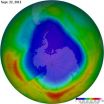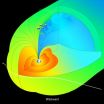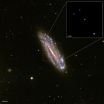(Press-News.org) Older patients who visited local ERs for chest pain or breathing problems and had chest x-rays reveal unknown spinal fractures, were more apt to receive osteoporosis treatment afterward if a simple intervention was used, recently published medical research from the University of Alberta has found.
Treatment rates for the bone-thinning condition substantially improved when patients and their family doctors received follow-up information about the warning signs and risk factors. It is the first and only trial in the world that looked at spinal osteoporosis.
Of those patients who weren't targeted with the intervention, only six per cent received follow-up treatment or testing for osteoporosis. When physicians were given educational material, the treatment or testing rate rocketed to 49 per cent. And when both the physicians and patients were informed, the rate climbed to 65 per cent of patients being treated or tested.
Faculty of Medicine & Dentistry researcher Sumit Majumdar was the principal investigator who led the study that was published in the peer-reviewed journal The American Journal of Medicine. It looked at patients over the age of 60 who visited two Edmonton emergency departments for various complaints and needed a chest x-ray, which incidentally revealed spinal fractures. One group of patients wasn't contacted for an intervention, only physicians were contacted in another group, and both physicians and their patients were contacted in a third group.
Family physicians targeted in the intervention received a one-page email, letter or fax from local doctors and nurses that explained osteoporosis treatment guidelines and recommendations. The same nurse phoned some patients to share the same information and answered patients' questions. These patients also received a pamphlet explaining the link between spinal fractures and osteoporosis.
"The information we provided was not new. But the fact it was linked to a specific patient and had specific advice, it acted as a reminder about what actions family doctors could take when they next saw that patient," says Majumdar.
"These fractures identified in chest x-rays are associated with a 20-fold increase of future fractures in people with osteoporosis – and these can be devastating fractures like fractures of the hip that can lead to nursing home admission or death," he says. "What was also concerning is that two-thirds of the patients in the study had a previously documented wrist or hip fracture before the x-ray was done, but they never received osteoporosis treatment."
Majumdar estimates the health-care system could save $1,000 per patient, if high-risk patients like the ones in this study received proper follow-up testing and treatment for osteoporosis. Hip fractures alone cost about $50,000 each to treat, and osteoporosis costs the Canadian health-care system about $1 billion a year.
When compared to the costs of the education intervention – $34 per physician and $42 per patient – "it's the equivalent of one month's supply of osteoporosis medication," says Majumdar.
One concerning revelation he noted in the study was that 25 per cent of the patients were men and none of them received followed-up treatment or testing as part of usual care.
Majumdar attributes this to the fallacy that "osteoporosis is considered a disease of older women." In fact, men have worse fractures and are more likely to die of hip fractures than women, said the researcher.
The research was funded by Knowledge Translation Canada, the Canadian Institutes of Health Research (CIHR) and Alberta Innovates – Health Solutions.
"This is both a research and a knowledge translation success story and CIHR would like to congratulate Dr. Majumdar on this important work," says Phillip Gardiner of the CIHR Institute of Musculoskeletal Health and Arthritis. "The health care costs associated with osteoporosis can be reduced and treatments improved when creative approaches like this are developed and implemented."
Majumdar hopes this educational intervention program could be a model for other conditions that could be identified in the ER, with follow-up care being co-ordinated by nurses or pharmacists.
Osteoporosis is a chronic and progressive condition that leads to fractures (typically of the upper extremity, spine or hip), acute and chronic pain, deformity, diminished quality of life, disability and loss of independence, nursing home admission and even death. It affects two million Canadians – about 25 per cent of women and 12 per cent of men over the age of 50.
A woman's lifetime risk of osteoporotic fracture is 40 to 50 per cent, while a man's risk is 12 to 20 per cent. In Canada, the annual cost of managing osteoporosis is estimated at $1 billion versus $750 million for heart failure or $600 million for asthma. Unless effective prevention strategies are implemented, the rates and costs of osteoporotic fractures are expected to double by 2025.
###
Majumdar is a professor in the Department of Medicine and an adjunct professor with the School of Public Health. He holds an endowed chair jointly supported by the Faculty of Medicine & Dentistry and the Faculty of Pharmacy and Pharmaceutical Sciences, and is a health scholar supported by Alberta Innovates – Health Solutions. END
U of A medical researchers use simple intervention to improve osteoporosis treatment rates
Patients with 'incidentally' detected spinal fractures more apt to receive osteoporosis treatment when physicians and patients targeted with educational intervention
2012-10-25
ELSE PRESS RELEASES FROM THIS DATE:
Pigs look healthy but test positive for flu at fairs; transmission seen between pigs and humans
2012-10-25
COLUMBUS, Ohio – More than 80 percent of pigs that tested positive for influenza A virus at Ohio county fairs between 2009 and 2011 showed no signs of illness, according to a new study.
Ohio State University researchers tested 20 pigs each at 53 fair events over those three summers and found at least one flu-positive pig at 12 fairs – almost a quarter of fairs tested.
The influenza strains identified in pigs in this study include H1N2 and H3N2 viruses – strains that have been circulating in pigs since 1998. In 2011, all of the H3N2 and H1N2 isolates found in pigs ...
Which candidate will be best for the stock market...?
2012-10-25
DeKALB, Ill. -- With Election Day less than a month away, television is filled with talking heads spreading the conventional wisdom of what a Republican or Democratic president might mean for the economy.
However, a group of researchers says, when it comes to the relationship between presidential politics and the behavior of the financial markets, conventional wisdom may not be so wise.
The researchers reviewed more than 40 years of data (1965-2008) in studying the relationship between security returns and four variables: the political affiliation of the president; ...
CU-Boulder researchers uncover new target for cancer research
2012-10-25
In a new paper released today in Nature, BioFrontiers Institute scientists at the University of Colorado Boulder, Tom Cech and Leslie Leinwand, detailed a new target for anti-cancer drug development that is sitting at the ends of our DNA.
Researchers in the two scientists' laboratories collaborated to find a patch of amino acids that, if blocked by a drug docked onto the chromosome end at this location, may prevent cancerous cells from reproducing. The amino acids at this site are called the "TEL patch" and once modified, the end of the chromosome is unable to recruit ...
2012 Antarctic ozone hole second smallest in 20 years
2012-10-25
WASHINGTON -- The average area covered by the Antarctic ozone hole
this year was the second smallest in the last 20 years, according to
data from NASA and National Oceanic and Atmospheric Administration
(NOAA) satellites. Scientists attribute the change to warmer
temperatures in the Antarctic lower stratosphere.
The ozone hole reached its maximum size Sept. 22, covering 8.2 million
square miles (21.2 million square kilometers), or the area of the
United States, Canada and Mexico combined. The average size of the
2012 ozone hole was 6.9 million square miles (17.9 ...
Plants provide accurate low-cost alternative for diagnosis of West Nile Virus
2012-10-25
While the United States has largely been spared the scourge of mosquito-borne diseases endemic to the developing world—including yellow fever, malaria and dengue fever—mosquito-related illnesses in the US are on the rise. One pathogen of increasing concern in the U.S. is an arbovirus known as West Nile.
Now Qiang "Shawn" Chen, a researcher at Arizona State University's Biodesign Institute and a professor in the College of Technology and Innovation has developed a new method of testing for West Nile, using plants to produce biological reagents for detection and diagnosis. ...
NASA study using cluster reveals new insights into solar wind
2012-10-25
A new study based on data from European Space Agency's Cluster mission shows that it is easier for the solar wind to penetrate Earth's magnetic environment, the magnetosphere, than had previously been thought. Scientists from NASA's Goddard Space Flight Center in Greenbelt, Md. have, for the first time, directly observed the presence of certain waves in the solar wind—called Kelvin-Helmholtz waves that can help transfer energy into near-Earth space—under circumstances when previous theories predicted they were not expected.
The recent paper, published on Aug 29, 2012, ...
Galaxy halos are produced by orphan stars, findings indicate
2012-10-25
Irvine, Calif., Oct. 24, 2012 – Isolated stars kicked to the edges of space by violent galaxy mergers may be the cause of mysterious infrared light halos observed across the sky, according to UC Irvine and other astronomers.
"Background glow in our sky has been a huge unanswered question," said UCI physics & astronomy professor Asantha Cooray, lead author of a paper about the discovery in the Oct. 25 issue of the journal Nature. "We have new evidence that this light is from stars that linger between galaxies. Individually, they're too dim to be seen, but we think we're ...
Video game with biofeedback teaches children to curb their anger
2012-10-25
Boston, Mass. , Oct. 24, 2012—Children with serious anger problems can be helped by a simple video game that hones their ability to regulate their emotions, finds a pilot study at Boston Children's Hospital. Results were published online October 24 in the journal Adolescent Psychiatry.
Noticing that children with anger control problems are often uninterested in psychotherapy, but very eager to play video games, Jason Kahn, PhD, and Joseph Gonzalez-Heydrich, MD, at Boston Children's Hospital developed "RAGE Control" to motivate children to practice emotional control skills ...
NASA satellite shows the Tropical Storm Son-tinh's reach over Philippines
2012-10-25
The latest tropical storm in the western North Pacific Ocean has already spread its clouds and showers over the Philippines, as seen in NASA satellite imagery. NASA's Aqua satellite captured an image as it flew over Tropical Storm Son-tinh today, Oct. 24.
On Oct. 24, 2012 at 0445 UTC (12:45 a.m. EDT) the Moderate Resolution Imaging Spectroradiometer (MODIS) instrument that flies aboard NASA's Aqua satellite captured a visible image of Tropical Storm Son-tinh. At the time of the image, Son-tinh's center was moving through the central Philippines, but its cloud cover extended ...
Revealing a mini-supermassive black hole
2012-10-25
One of the lowest mass supermassive black holes ever observed in the middle of a galaxy has been identified, thanks to NASA's Chandra X-ray Observatory and several other observatories. The host galaxy is of a type not expected to harbor supermassive black holes, suggesting that this black hole, while related to its supermassive cousins, may have a different origin.
The black hole is located in the middle of the spiral galaxy NGC 4178, shown in this image from the Sloan Digital Sky Survey. The inset shows an X-ray source at the position of the black hole, in the center ...
LAST 30 PRESS RELEASES:
Scientists use ultrasound to soften and treat cancer tumors without damaging healthy tissue
Community swimming program for Black youth boosts skills, sense of belonging, study finds
Specific depressive symptoms in midlife linked to increased dementia risk
An ‘illuminating’ design sheds light on cholesterol
Who is more likely to get long COVID?
Study showcases resilience and rapid growth of “living rocks”
Naval Research Lab diver earns Office of Naval Research 2025 Sailor of the Year
New Mayo-led study establishes practical definition for rapidly progressive dementia
Fossil fuel industry’s “climate false solutions” reinforce its power and aggravate environmental injustice
Researchers reveal bias in a widely used measure of algorithm performance
Alcohol causes cancer. A study from IOCB Prague confirms damage to DNA and shows how cells defend against it
Hidden viruses in wastewater treatment may shape public health risks, study finds
Unlock the power of nature: how biomass can transform climate mitigation
Biochar reshapes hidden soil microbes that capture carbon dioxide in farmland
Reducing saturated fat intake shows mortality benefit, but only in high-risk individuals
Manta rays create mobile ecosystems, study finds
Study: Mixed results in using lipoic acid to treat progressive multiple sclerosis
Norbert Holtkamp appointed director of Fermi National Accelerator Laboratory
New agentic AI platform accelerates advanced optics design
Biologists discover neurons use physical signals — not electricity — to stabilize communication
Researchers discover that a hormone can access the brain by hitchhiking
University of Oklahoma researcher awarded funding to pursue AI-powered material design
Exploring how the visual system recovers following injury
Support for parents with infants at pediatric check-ups leads to better reading and math skills in elementary school
Kids’ behavioral health is a growing share of family health costs
Day & night: Cancer disrupts the brain’s natural rhythm
COVID-19 vaccination significantly reduces risk to pregnant women and baby
The role of vaccination in maternal and perinatal outcomes associated with COVID-19 in pregnancy
Mayo Clinic smartwatch system helps parents shorten and defuse children's severe tantrums early
Behavioral health spending spikes to 40% of all children’s health expenditures, nearly doubling in a decade
[Press-News.org] U of A medical researchers use simple intervention to improve osteoporosis treatment ratesPatients with 'incidentally' detected spinal fractures more apt to receive osteoporosis treatment when physicians and patients targeted with educational intervention




